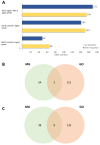Comparative Seeds Storage Transcriptome Analysis of Astronium fraxinifolium Schott, a Threatened Tree Species from Brazil
- PMID: 36430327
- PMCID: PMC9696909
- DOI: 10.3390/ijms232213852
Comparative Seeds Storage Transcriptome Analysis of Astronium fraxinifolium Schott, a Threatened Tree Species from Brazil
Abstract
Astronium fraxinifolium Schott (Anacardiaceae), also known as a 'gonçalo-alves', is a tree of the American tropics, with distribution in Mexico, part of Central America, Argentina, Bolivia, Brazil and Paraguay. In Brazil it is an endangered species that occurs in the Cerrado, Caatinga and in the Amazon biomes. In support of ex situ conservation, this work aimed to study two accessions with different longevity (p50) of A. fraxinifolium collected from two different geographic regions, and to evaluate the transcriptome during aging of the seeds in order to identify genes related to seed longevity. Artificial ageing was performed at a constant temperature of 45 °C and 60% relative humidity. RNA was extracted from 100 embryonic axes exposed to control and aging conditions for 21 days. The transcriptome analysis revealed differentially expressed genes such as Late Embryogenesis Abundant (LEA) genes, genes involved in the photosystem, glycine rich protein (GRP) genes, and several transcription factors associated with embryo development and ubiquitin-conjugating enzymes. Thus, these results contribute to understanding which genes play a role in seed ageing, and may serve as a basis for future functional characterization of the seed aging process in A. fraxinifolium.
Keywords: differentially expressed genes; seed longevity; transcription factors.
Conflict of interest statement
The authors declare that they have no conflict of interest.
Figures





Similar articles
-
Detection and application of novel SSR markers from transcriptome data for Astronium fraxinifolium Schott, a threatened Brazilian tree species.Mol Biol Rep. 2021 Apr;48(4):3165-3172. doi: 10.1007/s11033-021-06338-5. Epub 2021 Apr 18. Mol Biol Rep. 2021. PMID: 33866490
-
Morphological responses and tolerance of a tree native to the Brazilian Cerrado Astronium fraxinifolium Schott to boron toxicity.Environ Sci Pollut Res Int. 2022 Jan;29(5):6900-6910. doi: 10.1007/s11356-021-15710-8. Epub 2021 Aug 31. Environ Sci Pollut Res Int. 2022. PMID: 34467477
-
Astronium fraxinifolium Schott Exerts Leishmanicidal Activity by Providing a Classically Polarized Profile in Infected Macrophages.Acta Parasitol. 2020 Sep;65(3):686-695. doi: 10.2478/s11686-020-00200-7. Epub 2020 Apr 28. Acta Parasitol. 2020. PMID: 32347532
-
De novo transcriptome sequencing and gene expression analysis reveal potential mechanisms of seed abortion in dove tree (Davidia involucrata Baill.).BMC Plant Biol. 2016 Apr 12;16:82. doi: 10.1186/s12870-016-0772-x. BMC Plant Biol. 2016. PMID: 27068221 Free PMC article.
-
Spondias tuberosa Arruda (Anacardiaceae), a threatened tree of the Brazilian Caatinga?Braz J Biol. 2017 Jul-Sept;77(3):542-552. doi: 10.1590/1519-6984.18715. Epub 2016 Oct 24. Braz J Biol. 2017. PMID: 27783763 Review.
References
-
- Long R.L., Gorecki M.J., Renton M., Scott J.K., Colville L., Goggin D.E., Commander L.E., Westcott D.A., Cherry H., Finch-Savage W.E. The Ecophysiology of Seed Persistence: A Mechanistic View of the Journey to Germination or Demise: The Ecophysiology of Seed Persistence. Biol. Rev. 2015;90:31–59. doi: 10.1111/brv.12095. - DOI - PubMed
-
- Kijowska-Oberc J., Staszak A.M., Ratajczak E. Climate change affects seed aging? Initiation mechanism and consequences of loss of forest tree seed viability. Trees. 2021;35:1099–1108. doi: 10.1007/s00468-020-02072-w. - DOI
-
- Walters C., Pence V.C. The Unique Role of Seed Banking and Cryobiotechnologies in Plant Conservation. Plants People Planet. 2021;3:83–91. doi: 10.1002/ppp3.10121. - DOI
-
- Donà M., Balestrazzi A., Mondoni A., Rossi G., Ventura L., Buttafava A., Macovei A., Sabatini M.E., Valassi A., Carbonera D. DNA Profiling, Telomere Analysis and Antioxidant Properties as Tools for Monitoring Ex Situ Seed Longevity. Ann. Bot. 2013;111:987–998. doi: 10.1093/aob/mct058. - DOI - PMC - PubMed
-
- Faiad M.G.R., Goedert C.O., Wetzel M.M.V.S., Silva D.S., Pereira Neto L. Banco de Germoplasma de Sementes da Embrapa. Embrapa; Brasilia, Brazil: 2001. (Embrapa Recursos Genéticos e Biotecnologia. Documentos 71)
MeSH terms
Grants and funding
LinkOut - more resources
Full Text Sources
Research Materials

